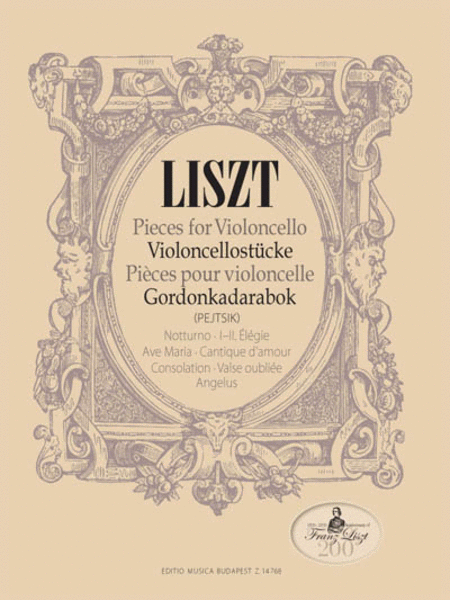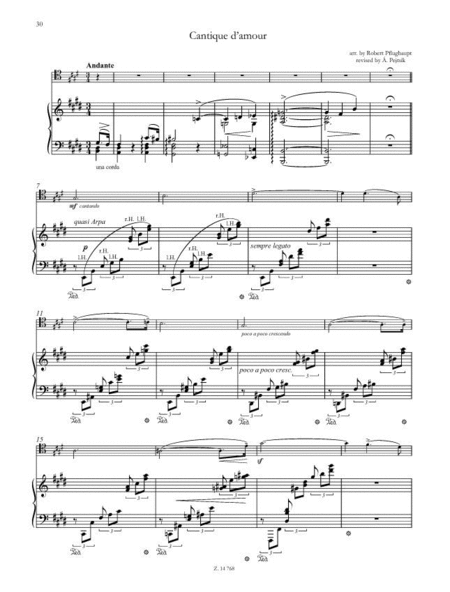Pieces for Violoncello
-
Ships in 2 to 3 weeks
Details
Description
SKU: BT.EMBZ14768
Composed by Franz Liszt. Book Only. Composed 2011. 76 pages. Editio Musica Budapest #EMBZ14768. Published by Editio Musica Budapest (BT.EMBZ14768).Not many people know that Franz Liszt arranged some of his piano pieces for the cello, with piano accompaniment, and that these versions of the works appeared in print during the maestro's lifetime. Árpád Pejtsik selected two of these for this volume compiled to mark Liszt's jubilee: Elegies I and II. The other compositions by Liszt that appear in the collection were likewise originally works for piano: the Ave Maria and Cantique d'amour (pieces from the Harmonies poétiques et religieuses cycle) were transcribed by a pupil of Liszt, Robert Pflughaupt the cello version, transposed into G major, of the E Major Consolation is by Jules de Swert, solo cellist in the Weimar orchestraof those days that of the Angelus (the opening piece in Volume 3 of the cycle entitled Years of Pilgrimage ) is by Lothar Windsperger, a German composer who lived at the turn of the 19th-20th century. The Valse oubliée No. 1 was transcribed by Liszt s virtuoso piano pupil Ferruccio Busoni Notturno, which became famous as the third piece in the Liebesträume series, is a transposed version of the original song ( O lieb, so lang du lieben kannst ) made by the editor of this volume.
Not many people know that Ferenc Liszt arranged some of his piano pieces for the cello, with piano accompaniment, and this version of the works appeared in print during the maestro's lifetime. Árpád Pejtsik selected two of these forthis volume compiled to mark Liszt's jubilee: Elegy I and Elegy II. The other compositions by Liszt that appear in the collection were likewise originally works for piano: the Ave Maria and Cantique d'amour(pieces from the Harmonies poétiques et religieuses cycle) were transcribed by a pupil of Liszt, Robert Pflughaupt; the cello version, transposed into G major, of the E major Consolation is by Jules de Swert, solo cellistin the Weimar orchestra of those days; that of the Angelus (the opening piece in Volume 3 of the cycle entitled Years of Pilgrimage) is by Lothar Windsperger, a German composer who lived at the turn of the 19th-20thcentury.
Nur Wenigen ist bekannt, dass Liszt einige seiner Klavierstücke auch für Violoncello mit Klavierbegleitung bearbeitet hatte, und dass diese Version der Werke noch zu Lebzeiten des Komponisten in Druck erschien. In diesem Band nahm Árpád Pejtsik zwei dieser Stücke, die I. und II. Elegie auf. Die anderen Liszt-Kompositionen in der Sammlung sind auch ursprünglich Klavierwerke: der Bearbeiter ist beim Ave Maria und Cantique d'amour (Stücke aus dem Zyklus Harmonies poétiques et religieuses) der Liszt-Schüler Robert Pflughaupt. Von Jules de Swert, der damals Solocellist des Weimarer Orchesters war, wurde die in G-Dur transponierte Violoncelloversion der E-Dur Consolation, und vonLothar Windsperger, dem an der Wende zum 20. Jahrhundert lebenden deutschen Komponisten, das Angelus (das Eröffnungsstück des III. Bandes des Zyklus Pilgerjahre) bearbeitet.


 Share
Share